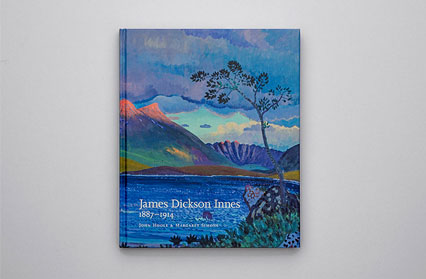192pp, Lund Humphries, £45.00
Innes the man, so to speak, has sunk into his grave almost without trace.
Sir John Rothenstein, Modern English Painters, Vol. II, 1956
August 1914 was not a very good month in which to die. Ever since his untimely death from pulmonary tuberculosis on August 22nd, a great deal about the life of Llanelli-born James Dickson Innes seemed destined to remain forever hidden in a biographical twilight to all but the most inquisitive of his admirers. Although not a direct casualty of the Great War himself, Innes’ death in a Kent nursing home after several years of ill health did, however, ensure that establishing any significant legacy for this post-impressionist pioneer would have to be postponed until 1921, when he was given a Memorial exhibition at the Tate Gallery. An early candidate for inclusion in the fabled twenty-seven club, a peripatetic Innes had travelled light through his short but adventurous lifetime leaving behind very little of substance to aid future art historians besides a number of high profile friendships and a back catalogue of increasingly uninhibited paintings. Much admired by many of the most influential collectors of his day, Innes’ quasi Fauvist landscapes had never entirely disappeared from public consciousness, but what few details of his personal life were known almost entirely emanated from the all too brief but compelling vignettes recorded in the reminiscences of others: in particular his friends, John Fothergill and Augustus John. Indeed, it was his close association with the then far more famous John and their friend Derwent Lees during a period of unparalleled creativity for the three of them that helped substantiate his reputation as both a daring colourist and a tragic bohemian.
Throughout much of 1935 Innes’s work had proved a revelation when viewed en-masse by many of his fellow countrymen for the first time during the touring exhibition, Contemporary Welsh Art. However by the time Sir John Rothenstein (former director of the Tate Gallery) came to write his own essay on the painter in 1956 he felt certain that too much time had already elapsed to fully do justice to the life of an artist whose work he himself greatly admired. That both John Hoole and Margaret Simons thought otherwise should therefore be applauded.
Published to commemorate the centenary of the artist’s death, James Dickson Innes 1887 – 1914 (Lund Humphries) is intended to serve as both catalogue raisonné and long awaited biography. Prior to his transformation of the mountains of north Wales into a département of the Midi it would seem there was little to set Innes apart from his contemporaries besides an obvious preference for portraying his native landscape over the then popular preoccupation with urban subject matter. An admirer of both Constable and Turner in his student days, examples of his work immediately post college clearly still bore the imprint of Philip Wilson Steer, one of his tutors at The Slade. Largely overlooked by earlier commentators in their pursuit of Innes the artistic innovator, much to her credit, Margaret Simons seems to have unearthed a significant amount of new material to flesh out Innes’ early years in Llanelli, Brecon and London. When it comes to elucidating her subject’s later harum-scarum lifestyle and reckless disregard for his own well-being, Simons has interwoven the relatively familiar commentaries of both John Fothergill and Augustus John together with other less well-publicised primary and secondary documentary sources to good effect.
Applying a conventional chronological format to Innes’ career, Simons’ heavy reliance on the testimony of both Fothergill and John unfortunately deserves to be treated with a certain degree of caution given the extensive passage of time between the majority of events chronicled and their eventual setting down. Concentrating her attention on Innes’ artistic rather than social development, little attempt has been made to place Innes within his wider surroundings beyond the colourful milieu in which he found himself once he had befriended John in 1907. Elsewhere a lack of cold hard facts would seem to bear out Rothenstein’s original prognosis as an unavoidable tone of speculation and conjecture permeates much of the record, although this is offset to a certain degree by the diligence Simons displays when it comes to detailing the more prosaic matter of the Innes family history and their arrival in Llanelli in 1860.
As one of only a handful of painters from Wales with a reputation beyond the border, the publication of this new volume is undoubtedly long overdue. That it has taken so long for art historians to recognise the importance of Innes as an individual in his own right rather than as a ‘significant other’ is perhaps not so surprising given that almost everything about Innes’ career as a painter lies beyond the now firmly established tropes of contemporary Welsh art history. A product of that most unrecognised of all national institutions, the Welsh public school, Innes’ hedonistic lifestyle and care-free expressionism hold little obvious appeal to those that prefer to see all artistic output as both formed by, and a response to, the prevailing socio-economic or geo-political circumstances of their time. Beautifully illustrated throughout with almost every page containing one or more colour plate, if today James Dickson Innes 1887 – 1914 feels a little reminiscent of an earlier period in art history publishing it is none the worse for this. Although at £45 a copy it is unlikely to do much to foster an appreciation of this most extrovert of Welsh artists amongst a new generation of admirers.
National Museum Wales: Landscapes by J. D. Innes: Beauty Most Wild – April 12th – July 20th 2014
Book cover design by Adrian Hunt











